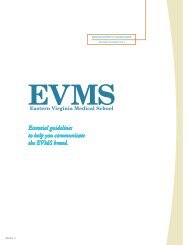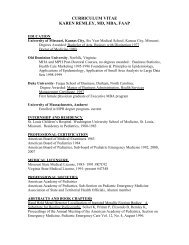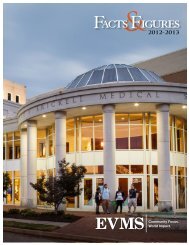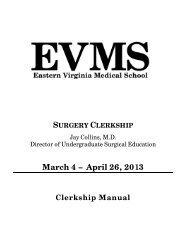in Hampton Roads in Hampton Roads - Eastern Virginia Medical ...
in Hampton Roads in Hampton Roads - Eastern Virginia Medical ...
in Hampton Roads in Hampton Roads - Eastern Virginia Medical ...
Create successful ePaper yourself
Turn your PDF publications into a flip-book with our unique Google optimized e-Paper software.
Scientists awarded nearly half a million dollars tofightType 1 DiabetesThe JDRF awarded atwo-year grant total<strong>in</strong>g$472,683 to the EVMSresearch team, led byJerry Nadler, MD.David Taylor-Fishwick, PhD, left, and Jerry Nadler, MD, discuss theirresearch that could lead to a cure for Type 1 Diabetes.A mount<strong>in</strong>g concern <strong>in</strong> the health carecommunity, diabetes affects about eight percentof the U.S. population, or 23.6 million people. And,unfortunately, these numbers are grow<strong>in</strong>g daily.Though current treatments allow diabetics tocontrol the condition, many are at high risk ofdangerous complications <strong>in</strong>clud<strong>in</strong>g heart disease,bl<strong>in</strong>dness, nerve damage and kidney problems.The U.S. Centers for Disease Control andPrevention report that <strong>in</strong> 2007, diabetes was thecountry’s fifth deadliest disease, and nationwidethe total direct and <strong>in</strong>direct cost of diabetes was$174 billion – more than twice the Department ofHealth and Human Services’ 2010 federal budget.Recognition of this grow<strong>in</strong>g epidemic and itsdetrimental impact on the <strong>Hampton</strong> <strong>Roads</strong> areawas the impetus beh<strong>in</strong>d the development of <strong>Eastern</strong>Virg<strong>in</strong>ia <strong>Medical</strong> School’s Strelitz Diabetes Centerand the school’s strategic research <strong>in</strong>itiative thatfocuses on diabetes, obesity and metabolic diseases.Now, EVMS researchers at the Strelitz DiabetesCenter believe they have uncovered a step thatcould lead to a cure for Type 1 Diabetes, and,with fund<strong>in</strong>g from the Juvenile Diabetes ResearchFoundation (JDRF), they hope to translate theirlaboratory f<strong>in</strong>d<strong>in</strong>gs <strong>in</strong>to cl<strong>in</strong>ical treatments.Previously known as juvenile diabetes becauseit is often diagnosed <strong>in</strong> children and young adults,Type 1 Diabetes is an autoimmune disorderassociated with the destruction of <strong>in</strong>sul<strong>in</strong>produc<strong>in</strong>gbeta cells. Without <strong>in</strong>sul<strong>in</strong>, the body isunable to process sugars and starches, leav<strong>in</strong>g itunable to convert them <strong>in</strong>to energy for movement,growth, repair and other functions.The JDRF awarded a two-year grant total<strong>in</strong>g$472,683 to the EVMS research team, led by JerryNadler, MD, professor and chair of <strong>in</strong>ternal medic<strong>in</strong>eand director of the center. The team has beenstudy<strong>in</strong>g the role of the enzyme 12- Lipoxygenase(12-LO) <strong>in</strong> damag<strong>in</strong>g <strong>in</strong>sul<strong>in</strong>-produc<strong>in</strong>g beta cells,a condition that leads to Type 1 Diabetes.“We have successfully identified a vital step <strong>in</strong>the development of Type 1 Diabetes and we arehopeful that block<strong>in</strong>g this enzyme could hold thekey to eng<strong>in</strong>eer<strong>in</strong>g breakthrough new treatments,”Dr. Nadler says.12-LO is a prote<strong>in</strong>-based enzyme <strong>in</strong> beta cellsthat produces lipids. These lipids are highly pro<strong>in</strong>flammatoryand can lead to the death of betacells. EVMS researchers have demonstrated<strong>in</strong> animal models that deletion of the gene thatproduces 12-LO prevents the development of Type1 Diabetes at a rate of nearly 100 percent.The group has now identified the particularform of 12-LO that is <strong>in</strong> human-<strong>in</strong>sul<strong>in</strong>-produc<strong>in</strong>gcells. And, though still prelim<strong>in</strong>ary, this researchcould help scientists develop a novel therapeuticapproach to stop beta cells from be<strong>in</strong>g destroyedand to allow functional regeneration of beta cells<strong>in</strong> Type 1 Diabetes patients.Work<strong>in</strong>g with Ted Holman, PhD, a professorof chemistry and biochemistry at the University ofCalifornia, Santa Cruz, and other scientists at theNIH, Dr. Nadler and his team hope to use thesef<strong>in</strong>d<strong>in</strong>gs to develop a new drug.“We are fortunate to be work<strong>in</strong>g with Dr.Holman, who has discovered some very promis<strong>in</strong>gcompounds that can reduce 12-LO activity. Now,with the generosity and support of the JDRF,we can apply this technology to help prevent thedestruction of beta cells and allow the regenerationof <strong>in</strong>sul<strong>in</strong>-produc<strong>in</strong>g cells <strong>in</strong> Type 1 Diabetes,” saysDr. Nadler.“Dr. Nadler and his team have made amaz<strong>in</strong>gstrides <strong>in</strong> our understand<strong>in</strong>g of how lipoxygenasemay contribute to the development of diabetes andtheir work opens the possibility of directly target<strong>in</strong>gthis enzyme for treatment,” said Dr. Holman.Based on this important discovery, Dr. Nadlerhas already begun test<strong>in</strong>g Dr. Holman’s lipoxygenase<strong>in</strong>hibitors <strong>in</strong> the hopes of generat<strong>in</strong>g new treatmentsfor diabetes. The researchers are excited about theprelim<strong>in</strong>ary results, and with the funds from JDRF,they expect to make additional progress.newswww.eVMS.EDU fall 20097
















